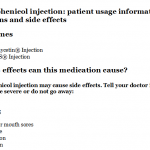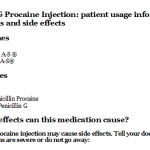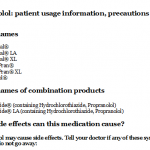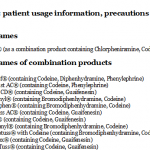
Engerix-B [Hepatitis B Vaccine (Recombinant): patient information, prescribing information, ingredients, manufacturer, adverse reactions and side effects
Sunday, April 09, 2017 by Gregory Van Dyke
http://www.naturalnewsreference.com/2017-04-09-engerix-b-hepatitis-b-vaccine-recombinant-patient-information-prescribing-information-ingredients-manufacturer-adverse-reactions-and-side-effects.html
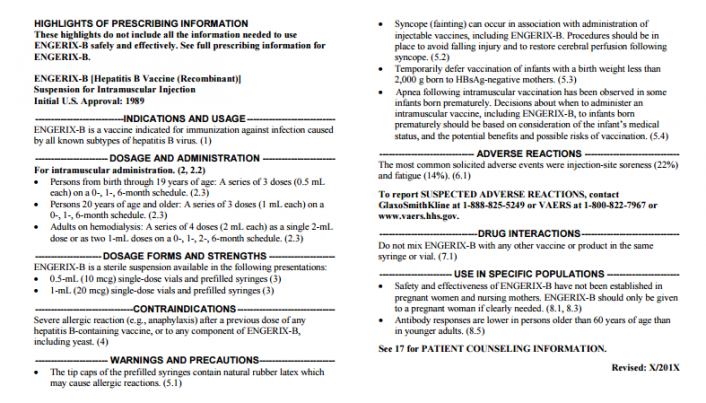
HIGHLIGHTS OF PRESCRIBING INFORMATION
These highlights do not include all the information needed to use ENGERIX-B safely and effectively. See full prescribing information for ENGERIX-B.
See full insert sheet at this link at the Natural News Reference website.
ENGERIX-B [Hepatitis B Vaccine (Recombinant)]
Suspension for Intramuscular Injection
Initial U.S. Approval: 1989
INGREDIENTS AND EXCIPIENTS
ENGERIX-B [Hepatitis B Vaccine (Recombinant)] is a sterile suspension of noninfectious hepatitis B virus surface antigen (HBsAg) for intramuscular administration. It contains purified surface antigen of the virus obtained by culturing genetically engineered Saccharomyces cerevisiae cells, which carry the surface antigen gene of the hepatitis B virus. The HBsAg expressed in the cells is purified by several physicochemical steps and formulated as a suspension of the antigen adsorbed on aluminum hydroxide. The procedures used to manufacture ENGERIX-B result in a product that contains no more than 5% yeast protein.
Each 0.5-mL pediatric/adolescent dose contains 10 mcg of HBsAg adsorbed on 0.25 mg aluminum as aluminum hydroxide.
Each 1-mL adult dose contains 20 mcg of HBsAg adsorbed on 0.5 mg aluminum as aluminum hydroxide.
ENGERIX-B contains the following excipients: Sodium chloride (9 mg/mL) and phosphate buffers (disodium phosphate dihydrate, 0.98 mg/mL; sodium dihydrogen phosphate dihydrate, 0.71 mg/mL).
ENGERIX-B is available in vials and prefilled syringes. The tip caps of the prefilled syringes contain natural rubber latex; the plungers are not made with natural rubber latex. The vial stoppers are not made with natural rubber latex.
ENGERIX-B is formulated without preservatives
INDICATIONS AND USAGE
ENGERIX-B is a vaccine indicated for immunization against infection caused by all known subtypes of hepatitis B virus
DOSAGE AND ADMINISTRATION
For intramuscular administration. (2, 2.2)
– Persons from birth through 19 years of age: A series of 3 doses (0.5 mL each) on a 0-, 1-, 6-month schedule. (2.3)
– Persons 20 years of age and older: A series of 3 doses (1 mL each) on a 0-, 1-, 6-month schedule. (2.3)
– Adults on hemodialysis: A series of 4 doses (2 mL each) as a single 2-mL dose or as two 1-mL doses on a 0-, 1-, 2-, 6-month schedule. (2.3)
DOSAGE FORMS AND STRENGTHS
ENGERIX-B is a sterile suspension available in the following presentations:
0.5-mL (10 mcg) single-dose vials and prefilled syringes (3)
1-mL (20 mcg) single-dose vials and prefilled syringes (3)
CONTRAINDICATIONS
Severe allergic reaction (e.g., anaphylaxis) after a previous dose of any hepatitis B-containing vaccine, or to any component of ENGERIX-B, including yeast
WARNINGS AND PRECAUTIONS
The tip caps of the prefilled syringes contain natural rubber latex which may cause allergic reactions. (5.1)
Syncope (fainting) can occur in association with administration of injectable vaccines, including ENGERIX-B. Procedures should be in place to avoid falling injury and to restore cerebral perfusion following syncope. (5.2)
Temporarily defer vaccination of infants with a birth weight less than 2,000 g born to HBsAg-negative mothers. (5.3)
Apnea following intramuscular vaccination has been observed in some infants born prematurely. Decisions about when to administer an intramuscular vaccine, including ENGERIX-B, to infants born prematurely should be based on consideration of the infant’s medical status, and the potential benefits and possible risks of vaccination. (5.4)
ADVERSE REACTIONS
The most common solicited adverse events were injection-site soreness (22%) and fatigue (14%). (6.1)
To report SUSPECTED ADVERSE REACTIONS, contact GlaxoSmithKline at 1-888-825-5249 or VAERS at 1-800-822-7967 or www.vaers.hhs.gov.
DRUG INTERACTIONS
Do not mix ENGERIX-B with any other vaccine or product in the same syringe or vial. (7.1)
USE IN SPECIFIC POPULATIONS
Pregnancy
Pregnancy Category C:Animal reproduction studies have not been conducted with ENGERIX-B. It is also not known whether ENGERIX-B can cause fetal harm when administered to a pregnant woman or can affect reproduction capacity. ENGERIX-B should be given to a pregnant woman only if clearly needed.
Nursing Mothers
It is not known whether ENGERIX-B is excreted in human milk. Because many drugs are excreted in human milk, caution should be exercised when ENGERIX-B is administered to a nursing woman.
Pediatric Use
Safety and effectiveness of ENGERIX-B have been established in all pediatric age groups. Maternally transferred antibodies do not interfere with the active immune response to the vaccine. [See Adverse Reactions (6), Clinical Studies (14.1, 14.3, 14.4).] The timing of the first dose in infants weighing less than 2,000 g at birth depends on the HBsAg status of the mother. [See Warnings and Precautions (5.3).]
Geriatric Use
Clinical studies of ENGERIX-B used for licensure did not include sufficient numbers of subjects 65 years of age and older to determine whether they respond differently from younger subjects. However, in later studies it has been shown that a diminished antibody response and
seroprotective levels can be expected in persons older than 60 years of age. [See Clinical Studies (14.2).]
Safety and effectiveness of ENGERIX-B have not been established in pregnant women and nursing mothers. ENGERIX-B should only be given to a pregnant woman if clearly needed. (8.1, 8.3)
Antibody responses are lower in persons older than 60 years of age than in younger adults. (8.5)
Revised: X/201X
https://www.fda.gov/downloads/BiologicsBloodVaccines/Vaccines/ApprovedProducts/UCM224503.pdf
http://naturalnewsreference.com/vaccine-insert-sheets/Engerix-B-Hepatitis-B-Vaccine.pdf
Tagged Under: Tags: dosage, engerix b, ingredients, insert sheet, side effects, usage, warnings

